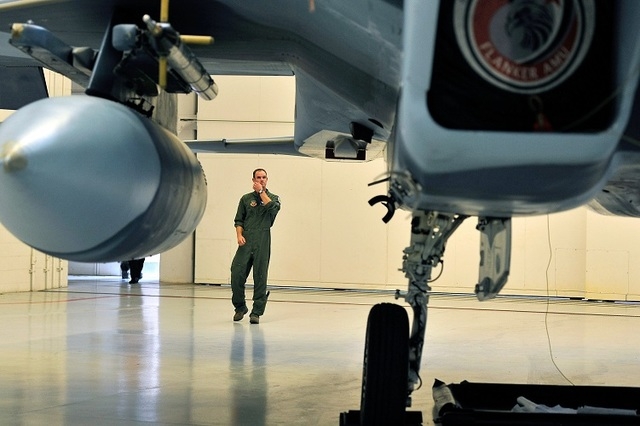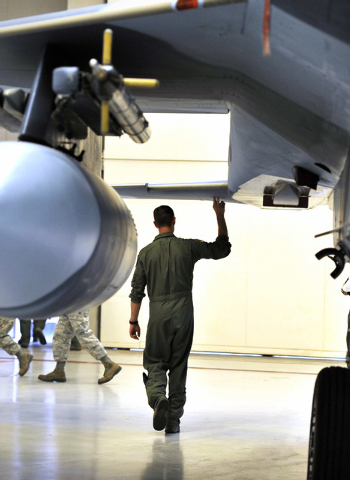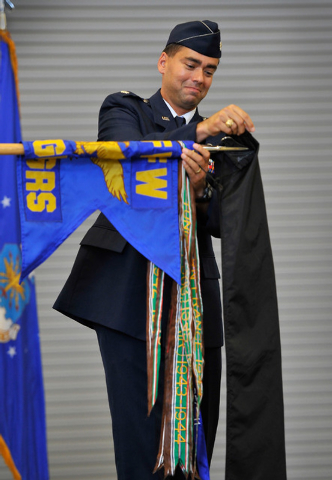65th Aggressor Squadron falls prey to Nellis budget cuts



Nellis Air Force Base closed a chapter Friday in the storied history of the 65th Aggressor Squadron, but the legacy of the pilots who flew its F-15 Eagles continues in the Middle East, where their U.S. and coalition sparring partners are bombing Islamic State targets.
“You have prepared the world’s greatest Air Force to fly, fight and win,” Col. Gary E. Rose, commander of the 57th Adversary Tactics Group, told the 65th’s pilots and maintenance personnel at the deactivation ceremony inside the squadron’s hangar at Nellis.
“I stand in awe of your accomplishments,” Rose said. He added that the airmen will continue in other roles “to build the next generation of airmen.”
In August, the 65th’s commander, Lt. Col. Greg “Papa” Wintill, told the Review-Journal that his squadron of 19 camouflage-painted F-15 Eagles would be deactivated to meet Pentagon budget constraints before the new fiscal year begins Oct. 1.
He said the squadron’s annual budget of about $35 million will be eliminated, including funding for the staff of 150 airmen who maintain the jets. Many will take on other assignments, but nine pilots will fly Red Flag air combat exercises with Nellis’ still-active 64th Aggressor Squadron until the end of March.
Then they will be transferred to other units or discontinued as operational aircraft. About 90 maintenance personnel from the 65th will make the six-month transfer to the 64th.
At Friday’s ceremony, Rose, the adversary tactics group commander, said, “We will train our air forces, when I say air forces I don’t just mean those of us in blue. I use that term to describe all airmen and air-power attributes, joint and coalition.”
Later in the ceremony, Wintill noted the importance of having would-be enemies to fly against over the sprawling Nevada Test and Training Range. “There is a reason so many countries send their people and spend their money to come here to Nellis Air Force Base to get the training from the adversary tactics group at Red Flag,” he said.
“As aggressors we must continue to learn and continue to update our tactics and remember not to underestimate our enemies,” Wintill said.
In recent Red Flag exercises, pilots from the 65th and 64th flew their respective F-15 and F-16 fighter jets as adversaries to train pilots from the United States and such coalition partners as Saudi Arabia, United Arab Emirates, Belgium, the Netherlands and the United Kingdom — air forces that are flying side by side with U.S. warplanes in the fight against Islamic State militants.
The 65th squadron also was used to test the capabilities of U.S. Air Force F-22 Raptors that made their combat debut Monday on missions against Islamic State targets in Syria.
An Air Combat Command spokesman at Langley Air Force Base in Virginia said that the maiden airstrikes of the F-22 were conducted by Langley’s 27th Fighter Squadron.
The supersonic F-22 cruiser can fly at 17 miles per minute and is the world’s foremost air-dominance operational attack jet. It was designed to replace the aging F-15 Eagle that until this week had been flown by the 65th Aggressor Squadron. The F-22 can drop smart bombs, fire air-to-air missiles and shoot a six-barrel cannon. Its high-tech gear enables pilots to evade enemy aircraft while giving them first-sight targeting capability.
The F-22, together with the F-35 joint strike fighter being tested at Nellis, will provide unmatched dominance in the skies, Air Force leaders have said.
The Air Combat Command spokesman confirmed that the roots of the stealthy jet are embedded at Nellis, where some of the first operational F-22s arrived in early 2003. They were assigned to the 422d Test and Evaluation Squadron to develop the initial tactics on how to employ the aircraft in combat. They also conducted the operational testing and trained several of the program’s initial pilots.
Nellis pilots wrote the initial playbook for the F-22, but they also continue to refine tactics, techniques, and procedures, integration of force packages, command and control and advanced combat training.
From the paint job on its planes to the pilots’ shoulder patches, the 65th Aggressor Squadron has simulated the enemy since it was activated Sept. 15, 2005, and a reactivation ceremony was held at Nellis on Jan. 12, 2006. Covers on the cockpit seat and intakes bore a yellow, hammer-and-sickle insignia inside the outline of a red star — the symbol of the United States’ enemy in the Cold War, the Soviet Union.
Known first as the 65th Pursuit Squadron in 1940 and two years later as the 65th Fighter Squadron, the squadron flying P-40s and P-47s racked up three distinguished unit citations for actions over North Africa, Sicily and Italy during World War II.
The 65th Aggressor Squadron flew during a brief stint at Nellis in 1969-70 when it was known as the 65th Fighter Weapons Squadron. It later served at Nellis from 1983 through 1989, when its pilots flew F-5E Tiger II aircraft.
In August, Wintill said the role of the aggressor pilot “is really about being a sparring partner. Everybody needs a sparring partner that’s tough.”
“And the tougher the sparring partner your are … the tougher that practice team is, the better the real team is when they go out and fight in combat,” he said.
Contact Keith Rogers at krogers@reviewjournal.com or 702-383-0308. Find him on Twitter: @KeithRogers2.












